I originally sat down to come up with a top 10 list of native Arkansas plants for pollinators but couldn’t do it. It’s a tough job because there are so many good ones. Honestly, it would be easier to come up with a top 50 or even a top 25. Given the diversity of habitats and growing conditions in the state though, a list of top genera is more appropriate anyway, to give gardeners the flexibility needed to address different sites. So here is a list of 15 genera* of native plants that I see getting a lot of attention from pollinators in both our wild lands and in my garden. Each has multiple species, and different ones may be more suitable for different sites or in different regions. If you want to see which species are in your part of the state, check out the “Atlas of the Vascular Plants of Arkansas,” now available as a free, downloadable PDF. See also the ANHC’s Native Gardening Guide.
(All photos below can be viewed at a larger size by clicking on them.)
 Bluestar (Amsonia spp.*) – We have at least five species of native bluestar in Arkansas. The eastern bluestar (Amsonia tabernaemontana) is the most shade tolerant of the lot and is found in upland woodlands, while the rest are found in open, seasonally wet habitats. All like a little moisture in the spring but are remarkably drought tolerant once established. They all have pale blue to nearly white flowers and rich yellow to golden fall leaf color.
Bluestar (Amsonia spp.*) – We have at least five species of native bluestar in Arkansas. The eastern bluestar (Amsonia tabernaemontana) is the most shade tolerant of the lot and is found in upland woodlands, while the rest are found in open, seasonally wet habitats. All like a little moisture in the spring but are remarkably drought tolerant once established. They all have pale blue to nearly white flowers and rich yellow to golden fall leaf color.
 Milkweeds (Asclepias spp.) – Fourteen species of true milkweeds (in the genus Asclepias) are known in Arkansas as well as seven other species of vining milkweeds (in the genera Cynanchum, Funastrum, Gonolobus, and Matelea). The true milkweeds are well known as the host plants for the monarch butterfly (Danaus plexippus) but are also important nectar plants for a wide variety of insects. Most of ours like sunny conditions, but three species — purple milkweed (Asclepias purpurascens), four-leaf milkweed (Asclepias quadrifolia), and white milkweed (Asclepias variegata) — do well in woodlands.
Milkweeds (Asclepias spp.) – Fourteen species of true milkweeds (in the genus Asclepias) are known in Arkansas as well as seven other species of vining milkweeds (in the genera Cynanchum, Funastrum, Gonolobus, and Matelea). The true milkweeds are well known as the host plants for the monarch butterfly (Danaus plexippus) but are also important nectar plants for a wide variety of insects. Most of ours like sunny conditions, but three species — purple milkweed (Asclepias purpurascens), four-leaf milkweed (Asclepias quadrifolia), and white milkweed (Asclepias variegata) — do well in woodlands.
 Rattlesnake-masters and Eryngos (Eryngium spp.) – Arkansas is home to five species in this genus, but the most widespread and garden-worthy is rattlesnake-master (Eryngium yuccifolium). This is an excellent insect plant with showy, spikey, ball-like heads of white flowers. Its leaves are tough and similar in appearance to those of yucca, and the scientific name means “eryngo with the yucca leaves.”
Rattlesnake-masters and Eryngos (Eryngium spp.) – Arkansas is home to five species in this genus, but the most widespread and garden-worthy is rattlesnake-master (Eryngium yuccifolium). This is an excellent insect plant with showy, spikey, ball-like heads of white flowers. Its leaves are tough and similar in appearance to those of yucca, and the scientific name means “eryngo with the yucca leaves.”
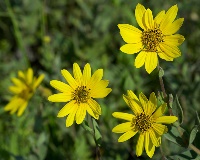 Sunflowers (Helianthus spp.) – Sixteen sunflowers are found in Arkansas and at least 15 are definitely native. Like many large genera there is a species that will work in most different sites—from wet to dry and full sun to shade. Most of the perennial species spread by creeping rhizomes to form colonies, so give them a little room. They range in height from short (one to three feet) in ashy sunflower (Helianthus mollis) to very tall (12 feet or more) in sawtooth sunflower (Helianthus grosseserratus). All are excellent for a wide variety of insects, including bees.
Sunflowers (Helianthus spp.) – Sixteen sunflowers are found in Arkansas and at least 15 are definitely native. Like many large genera there is a species that will work in most different sites—from wet to dry and full sun to shade. Most of the perennial species spread by creeping rhizomes to form colonies, so give them a little room. They range in height from short (one to three feet) in ashy sunflower (Helianthus mollis) to very tall (12 feet or more) in sawtooth sunflower (Helianthus grosseserratus). All are excellent for a wide variety of insects, including bees.
 Blazing-stars and Gayfeathers (Liatris spp.) – At least 13 native blazing-stars and gayfeathers are known from Arkansas, all with pink to (rarely) white flowers, and all dependent on at least partial sun. Different species can accommodate seasonally wet to dry conditions and soils ranging from heavy clays to deep sand and range from short (1–2 feet) in Ouachita blazing-star (Liatris compacta) and scaly blazing-star (Liatris hirsuta) to fairly tall (4–6 feet or so) in rough blazing-star (Liatris aspera) and Appalachian blazing-star (Liatris squarrulosa).
Blazing-stars and Gayfeathers (Liatris spp.) – At least 13 native blazing-stars and gayfeathers are known from Arkansas, all with pink to (rarely) white flowers, and all dependent on at least partial sun. Different species can accommodate seasonally wet to dry conditions and soils ranging from heavy clays to deep sand and range from short (1–2 feet) in Ouachita blazing-star (Liatris compacta) and scaly blazing-star (Liatris hirsuta) to fairly tall (4–6 feet or so) in rough blazing-star (Liatris aspera) and Appalachian blazing-star (Liatris squarrulosa).
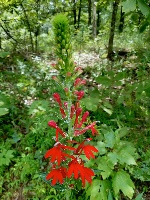 Lobelias (Lobelia spp.) – Six lobelias are found in Arkansas. The most famous are the brilliant red cardinal flower (Lobelia cardinalis) and the great blue lobelia (Lobelia siphilitica), both of which like their feet wet. There are also upland species, however, with flowers ranging from white to bright blue and purple, though they are not quite as showy as the wetland species.
Lobelias (Lobelia spp.) – Six lobelias are found in Arkansas. The most famous are the brilliant red cardinal flower (Lobelia cardinalis) and the great blue lobelia (Lobelia siphilitica), both of which like their feet wet. There are also upland species, however, with flowers ranging from white to bright blue and purple, though they are not quite as showy as the wetland species.
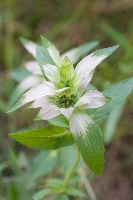 Beebalms and Horsemints (Monarda spp.) – Powerhouses for drawing insects, seven kinds of Monarda are known in the state, with flowers ranging from white with red spots to pink to yellow, and at home in a variety of soils in full to partial sun. One of these, Monarda fistulosa var. stipatatoglandulosa is endemic to the Ouachita Mountains, where it is common, but is found nowhere else in the world. Two species, lemon bee balm (Monarda citriodora) and dotted beebalm (Monarda punctata), are annuals while the rest are perennials that will creep slowly to form a patch.
Beebalms and Horsemints (Monarda spp.) – Powerhouses for drawing insects, seven kinds of Monarda are known in the state, with flowers ranging from white with red spots to pink to yellow, and at home in a variety of soils in full to partial sun. One of these, Monarda fistulosa var. stipatatoglandulosa is endemic to the Ouachita Mountains, where it is common, but is found nowhere else in the world. Two species, lemon bee balm (Monarda citriodora) and dotted beebalm (Monarda punctata), are annuals while the rest are perennials that will creep slowly to form a patch.
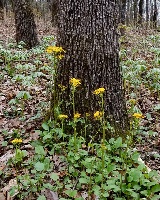 Ragworts and Groundsels (Packera spp.) – There are at least seven ragworts and groundsels in the genus Packera in Arkansas, and they provide a reliable early nectar resource and display of yellow flowers. Most of our species are slow-creeping perennials. Plant round-leaf ragwort (Packera obovata) with spring-blooming species of Phlox, columbine (Aquilegia canadensis), wild geranium (Geranium maculatum), and crested iris (Iris cristata) for a great spring display that will benefit woodland insects.
Ragworts and Groundsels (Packera spp.) – There are at least seven ragworts and groundsels in the genus Packera in Arkansas, and they provide a reliable early nectar resource and display of yellow flowers. Most of our species are slow-creeping perennials. Plant round-leaf ragwort (Packera obovata) with spring-blooming species of Phlox, columbine (Aquilegia canadensis), wild geranium (Geranium maculatum), and crested iris (Iris cristata) for a great spring display that will benefit woodland insects.
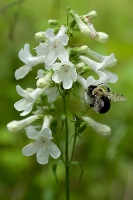 Beardtongues (Penstemon spp.) – Our nine species of Penstemon are a diverse group for gardeners to work with, ranging in color from bright red to purple, pink, and white and with various species at home in wet to dry sites in full sun to partial shade. All are relatively well-behaved, clump-forming perennials.
Beardtongues (Penstemon spp.) – Our nine species of Penstemon are a diverse group for gardeners to work with, ranging in color from bright red to purple, pink, and white and with various species at home in wet to dry sites in full sun to partial shade. All are relatively well-behaved, clump-forming perennials.
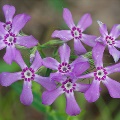 Phloxes (Phlox spp.) – Eight kinds of native phlox can be found in Arkansas blooming from early spring to late summer and ranging from white to pale blue to pink and purple, with species for both wet and dry sites. The spring-blooming downy phlox (Phlox pilosa) is probably our most versatile member of the genus, suitable for a variety of sites and coming in various colors from white to pink to lavender. Wild blue phlox (Phlox divaricata subsp. laphamii) is an excellent choice for the shade garden.
Phloxes (Phlox spp.) – Eight kinds of native phlox can be found in Arkansas blooming from early spring to late summer and ranging from white to pale blue to pink and purple, with species for both wet and dry sites. The spring-blooming downy phlox (Phlox pilosa) is probably our most versatile member of the genus, suitable for a variety of sites and coming in various colors from white to pink to lavender. Wild blue phlox (Phlox divaricata subsp. laphamii) is an excellent choice for the shade garden.
 Mountain Mints (Pycnanthemum spp.) – There are few native plants as popular with the insects as our five native mountain mints. When you walk up on a population in full bloom, you can often hear the buzz of dozens of species of insects at a distance and are in for a real show of insect diversity including bees, wasps, beetles, butterflies, and moths. All have fragrant foliage as well, with the chemistry responsible apparently variable even within a species so that the crushed leaves of individuals of a single species may smell strongly minty, like oregano, or like lemon.
Mountain Mints (Pycnanthemum spp.) – There are few native plants as popular with the insects as our five native mountain mints. When you walk up on a population in full bloom, you can often hear the buzz of dozens of species of insects at a distance and are in for a real show of insect diversity including bees, wasps, beetles, butterflies, and moths. All have fragrant foliage as well, with the chemistry responsible apparently variable even within a species so that the crushed leaves of individuals of a single species may smell strongly minty, like oregano, or like lemon.
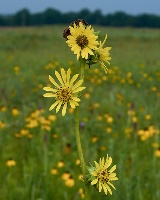 Rosinweeds and Compass Plants (Silphium spp.) – Seven species in the genus Silphium can be found in Arkansas’s grasslands and open woodlands. Cousins to the superficially similar sunflowers (Helianthus), most of our species get tall and are great for the rear of a border garden or the center of an island garden. There are species for moist sites like cup plant (Silphium perfoliatum) or for very dry sites, like compass plant (Silphium laciniatum), and everything in between. Most like full sun, but starry rosinweed (Silphium asteriscus) is a shorter woodland species that likes partial shade.
Rosinweeds and Compass Plants (Silphium spp.) – Seven species in the genus Silphium can be found in Arkansas’s grasslands and open woodlands. Cousins to the superficially similar sunflowers (Helianthus), most of our species get tall and are great for the rear of a border garden or the center of an island garden. There are species for moist sites like cup plant (Silphium perfoliatum) or for very dry sites, like compass plant (Silphium laciniatum), and everything in between. Most like full sun, but starry rosinweed (Silphium asteriscus) is a shorter woodland species that likes partial shade.
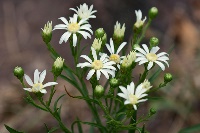 Goldenrods (Solidago spp.) – With more than 30 different goldenrods native to Arkansas, there is at least one for just about any site. They range from compact and very well-behaved to tall, aggressive, and weedy, and there are species for everything from dry sites with full sun to moist sites in the shade. Goldenrods are a very important fall nectar resource for insects. All the species in Arkansas have yellow flowers except the white flat-top goldenrod (Solidago ptarmicoides). Some of these can be a little weedy or aggressive for the small garden, so do some research before planting (a good starting point is the article “Some Native Gardening Basics I Learned the Hard Way”).
Goldenrods (Solidago spp.) – With more than 30 different goldenrods native to Arkansas, there is at least one for just about any site. They range from compact and very well-behaved to tall, aggressive, and weedy, and there are species for everything from dry sites with full sun to moist sites in the shade. Goldenrods are a very important fall nectar resource for insects. All the species in Arkansas have yellow flowers except the white flat-top goldenrod (Solidago ptarmicoides). Some of these can be a little weedy or aggressive for the small garden, so do some research before planting (a good starting point is the article “Some Native Gardening Basics I Learned the Hard Way”).
 Asters (Symphyotrichum spp.) – A wonderfully diverse genus, there are more than 30 different native asters in Arkansas. Like the goldenrods, they are a very important fall nectar resource, but unlike the goldenrods they come in a variety of colors ranging from white to blue to deep purple. Plant with goldenrods for a great display of fall color.
Asters (Symphyotrichum spp.) – A wonderfully diverse genus, there are more than 30 different native asters in Arkansas. Like the goldenrods, they are a very important fall nectar resource, but unlike the goldenrods they come in a variety of colors ranging from white to blue to deep purple. Plant with goldenrods for a great display of fall color.
 Violets (Viola spp.) – At least 15 native violets can be found in Arkansas and are an important early spring nectar resource as well as the larval host plant for our state butterfly, the Diana fritillary (Speyeria diana). While most of our violets have blue to purple flowers, we also have species with white, cream, or bright yellow flowers. As with many of our larger genera, there are species for a variety of sites with varying levels of moisture and sunlight.
Violets (Viola spp.) – At least 15 native violets can be found in Arkansas and are an important early spring nectar resource as well as the larval host plant for our state butterfly, the Diana fritillary (Speyeria diana). While most of our violets have blue to purple flowers, we also have species with white, cream, or bright yellow flowers. As with many of our larger genera, there are species for a variety of sites with varying levels of moisture and sunlight.
*Genera – Genera is plural for genus.
Scientists group similar living things (organisms) together using a system of classification and naming called taxonomy. All life is classified into three large groups called Domains. From there, each grouping becomes more and more narrow, grouping into the more general Kingdom, down into more and more specific groupings, from Phylum to Class to Order to Family, to Genus, ending with Species. Each organism has its own specific name, called a scientific name, which includes the genus and species name. The scientific name is Latin and is written in italics. The genus name is capitalized, but the species name is not. For example, the scientific name for eastern bluestar is Amsonia tabernaemontana. Amsonia is the genus name and tabernaemontana is the species name.
*spp. – This is an abbreviation of “several species” used after the genus name. It means two or more species of the same genus. The abbreviation is not italicized.
Photos:
Photo 1 — Eastern bluestar (Amsonia tabernaemontana). Photo by Eric Hunt.
Photo 2 — Four-leaf milkweed (Asclepias quadrifolia). Photo by Eric Hunt.
Photo 3 — Rattlesnake master (Eryngium yuccifolium). Photo by Eric Hunt.
Photo 4 — Ashy sunflower (Helianthus mollis). Photo by Eric Hunt.
Photo 5 — Scaly blazing-star (Liatris hirsuta). Photo by Eric Hunt.
Photo 6 — Cardinal flower (Lobelia carinalis). Photo by Eric Hunt.
Photo 7 — Dotted beebalm (Monarda punctata). Photo by Eric Hunt.
Photo 8 — Round-leaf ragwort (Packera obovata). Photo by Eric Hunt.
Photo 9 — White-wand beardtongue (Penstemon tubiflorus). Photo by Eric Hunt.
Photo 10 — Downy phlox (Phlox pilosa). Photo by Eric Hunt.
Photo 11 — Slender mountain mint (Pycnanthemum tenuifolium). Photo by Eric Hunt.
Photo 12 — Compass plant (Silphium laciniatum). Photo by Eric Hunt.
Photo 13 — White flat-top goldenrod (Solidago ptarmicoides). Photo by Eric Hunt.
Photo 14 — Manray aster (Symphyotrichum anomalum). Photo by Eric Hunt.
Photo 15 — Bird's-foot violet (Viola pedata). Photo by Eric Hunt.
